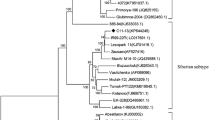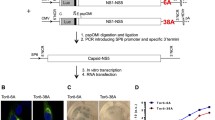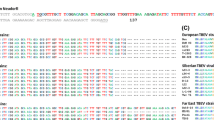Abstract
The tick-borne encephalitis virus (TBEV) strain C11-13 (GenBank acc. no. OQ565596) of the Siberian genotype was previously isolated from the brain of a deceased person. TBEV C11-13 variants obtained at passages 3 and 8 in SPEV cells were inoculated into the brains of white mice for subsequent passages. Full genome sequences of all virus variants were analyzed by high-throughput sequencing. A total of 41 single nucleotide substitutions were found to occur mainly in the genes for the nonstructural proteins NS3 and NS5 (GenBank MF043953, OP902894, and OP902895), and 12 amino acid substitutions were identified in the deduced protein sequences. Reverse nucleotide and amino acid substitutions were detected after three passages through mouse brains. The substitutions restored the primary structures that were characteristic of the isolate C11-13 from a human patient and changed during the eight subsequent passages in SPEV cells. In addition, the 3′-untranslated region (3′-UTR) of the viral genome increased by 306 nt. The Y3 and Y2 3'-UTR elements were found to contain imperfect L and R repeats, which were probably associated with inhibition of cellular XRN1 RNase and thus involved in the formation of subgenomic flaviviral RNAs (sfRNAs). All TBEV variants showed high-level reproduction in both cell cultures and mouse brains. The genomic changes that occurred during successive passages of TBEV are most likely due to its significant genetic variability, which ensures its efficient reproduction in various hosts and its broad distribution in various climatic zones.





Similar content being viewed by others
REFERENCES
Charrel R.N., Attoui H., Butenko A.M., Clegg J.C., Deubel V., Frolova T.V., Gould E.A., Gritsun T.S., Heinz F.X., Labuda M., Lashkevich V.A., Loktev V., Lundkvist A., Lvov D.V., Mandl C.W., Niedrig M., Papa A., Petrov V.S., Plyusnin A., Randolph S., Süss J., Zlobin V.I., de Lamballerie X. 2014. Tick-borne virus diseases of human interest in Europe. Clin. Microbiol. Infect. 10 (12), 1040‒1055. https://doi.org/10.1111/j.1469-0691.2004.01022.x
Ruzek D.Z., Avšič Županc T., Borde J., Chrdle A., Eyer L., Karganova G., Kholodilov I., Knap N., Ko-zlovskaya L., Matveev A., Miller A.D., Oso-lodkin D.I., Överby A.K., Tikunova N., Tkachev S., Zajkowska J. 2019. Tick-borne encephalitis in Europe and Russia: Review of pathogenesis, clinical features, therapy, and vaccines. Antiviral Res. 164, 23–51. https://doi.org/10.1016/j.antiviral.2019.01.014
Khasnatinov M.A., Ustanikova K., Frolova T.V., Pogodina V.V., Bochkova N.G., Levina L.S., Slovak M., Kazimirova M., Labuda M., Klempa B., Eleckova E., Gould E.A., Gritsun T.S. 2009. Non-hemagglutinating flaviviruses: Molecular mechanisms for the emergence of new strains via adaptation to European ticks. PLoS One. 4, e7295. https://doi.org/10.1371/journal.pone.0007295
Deviatkin A.A., Kholodilov I.S., Vakulenko Y.A., Karganova G.G., Lukashev A.N. 2020. Tick-borne encephalitis virus: An emerging ancient zoonosis? Viruses. 12, 247. https://doi.org/10.3390/v12020247
Wang S.S., Liu J.Y., Wang B.Y., Wang W.J., Cui X.M., Jiang J.F., Sun Y., Guo W.B., Pan Y.S., Zhou Y.H., Lin Z.T., Jiang B.G., Zhao L., Cao W.C. 2023. Geographical distribution of Ixodes persulcatus and associated pathogens: Analysis of integrated data from a China field survey and global published data. One Health. 16, 100508. https://doi.org/10.1016/j.onehlt.2023.100508
Chausov E.V., Ternovoi V.A., Protopopova E.V., Kononova J.V., Konovalova S.N., Pershikova N.L., Loktev V.B., Romanenko V.N., Ivanova N.V., Bolshakova N.P., Moskvitina N.S. 2010. Variability of the tick-borne encephalitis virus genome in the 5′ noncoding region derived from ticks Ixodes persulcatus and Ixodes pavlovskyi in Western Siberia. Vector Borne Zoonotic Dis. 10, 365‒375. https://doi.org/10.1089/vbz.2009.0064
Ternovoi V.A., Gladysheva A.V., Ponomareva E.P., Mikryukova T.P., Protopopova E.V., Shvalov A.N., Konovalova S.N., Chausov E.V., Loktev V.B. 2019. Variability in the 3′ untranslated regions of the genomes of the different tick-borne encephalitis virus subtypes. Virus Genes. 55, 448‒457. https://doi.org/10.1007/s11262-019-01672-0
Gritsun T.S., Gould E.A. 2006. The 3' unrtanslated region of tick-borne flaviviruses originated by the duplication of long repeat sequences within the open reading frame. Virology. 354, 217‒223. https://doi.org/10.1016/j.virol.2006.03.052
Gritsun T.S., Gould E.A. 2006. Direct repeats in the 3' untranslated regions of mosquito-borne flaviviruses: Possible implications for virus transmission. J. Gen. Virol. 87 (Pt. 11), 3297‒3305. https://doi.org/10.1099/vir.0.82235-0
Gritsun T.S., Gould E.A. 2007. Origin and evolution of flavivirus 5' UTRs and panhandles: Trans-terminal duplications? Virology. 366, 8‒15. https://doi.org/10.1016/j.virol.2007.04.011
Alvarez D.E., Filomatori C.V., Gamarnik A.V. 2008. Functional analysis of dengue virus cyclization sequences located at the 5′ and 3′ UTRs. Virology. 375, 223‒235.
Ecker M., Allison S.L., Meixner T., Heinz F.X. 1999. Sequence analysis and genetic classification of tick-borne encephalitis viruses from Europe and Asia. J. Gen. Virol. 80 (Pt. 1), 179–185. https://doi.org/10.1099/0022-1317-80-1-179
Demina T.V., Dzhioev Y.P., Verkhozina M.M., Kozlova I.V., Tkachev S.E., Plyusnin A., Doroshchen-ko E.K., Lisak O.V., Zlobin V.I. 2010. Genotyping and characterization of the geographical distribution of tick-borne encephalitis virus variants with a set of molecular probes. J. Med. Virol. 82, 965–976. https://doi.org/10.1002/jmv
Kozlova I.V., Demina T.V., Tkachev S.E., Doroshchenko E.K., Lisak O.V., Verkhozina M.M., Karan L.S., Dzhioev Y.P., Paramonov, A.I., Suntsova O.V., Savinova Y.S., Chernoivanova O.O., Ruzek D., Tikunova N.V., Zlobin V.I. 2018. Characteristics of the Baikal subtype of tick-borne encephalitis virus circulating in Eastern Siberia. Acta Biomed. Sci. 3 (4), 53–60. https://doi.org/10.29413/ABS.2018-3.4.9
Dai X., Shang G., Lu S., Yang J., Xu J. 2018. A new subtype of eastern tick-borne encephalitis virus discovered in Qinghai-Tibet Plateau, China. Emerg. Microbes Infect. 7, 74. https://doi.org/10.1038/s41426-018-0081-6
Ternovoi V.A., Protopopova E.V., Chausov E.V., Novikov D.V., Leonova G.N., Netesov S.V., Loktev V.B. 2007. Novel variant of tickborne encephalitis virus, Russia. Emer. Infect. Dis. 13, 1574‒1578. https://doi.org/10.3201/eid1310.070158
Chausov E.V., Ternovoy V.A., Protopopova E.V., Konovalova S.N., Kononova Yu.V., Tupota N.L., Moskvitina N.S., Romanenko V.N., Ivanova N.V., Bol’shakova N.P., Leonova G.N., Loktev V.B. 2011. Molecular genetic analysis of the complete genome of tick-borne encephalitis virus (Siberia Subtype): Modern Kolarovo-2008 isolate. Probl. Osobo Opasnykh Infekts. 4 (110), 44–48. https://doi.org/10.21055/0370-1069-2011-4(110)-44-48
Mikryukova T.P., Moskvitina N.S., Kononova Y.V., Korobitsyn I.G., Kartashov M.Y., Tyutenkov O.Y., Protopopova E.V., Romanenko V.N., Chausov E.V., Gashkov S.I., Konovalova S.N., Moskvitin S.S., Tupota N.L., Sementsova A.O., Ternovoi V.A., Loktev V.B. 2014. Surveillance of tick-borne encephalitis virus in wild birds and ticks in Tomsk city and its suburbs (Western Siberia). Ticks Tick Borne Dis. 5 (2), 145‒151. https://doi.org/10.1016/j.ttbdis.2013.10.004
Mikriukova T.P., Chausov E.V., Konovalova S.N., Kononova Iu.V., Protopopova E.V., Kartashov M.Iu., Ternovoi V.A., Glushkova L.I., Korabel’nikov I.V., Egorova I.Iu., Loktev V.B. 2014. Genetic diversity of the tick-borne encephalitis virus in Ixodes persulcatus ticks in northeastern European Russia. Parazitologiya. 48 (2), 131‒149.
Korobitsyn I.G., Moskvitina N.S., Tyutenkov O.Y., Gashkov S.I., Kononova Y.V., Moskvitin S.S., Romanenko V.N., Mikryukova T.P., Protopopova E.V., Kartashov M.Y., Chausov E.V., Konovalova S.N., Tupota N.L., Sementsova A.O., Ternovoi V.A., Loktev V.B. 2021. Detection of tick-borne pathogens in wild birds and their ticks in Western Siberia and high level of their mismatch. Folia Parasitol. (Praha). 68, 2021‒2024. https://doi.org/10.14411/fp.2021.024
Ponomareva E.P., Ternovoi V.A., Mikryukova T.P., Protopopova E.V., Gladysheva A.V., Shvalov A.N., Konovalova S.N., Chausov E.V., Loktev V.B. 2017. Adaptation of tick-borne encephalitis virus from human brain to different cell cultures induces multiple genomic substitutions. Arch. Virol. 162, 3151‒3156. https://doi.org/10.1007/s00705-017-3442-x
National Research Council. 1996. Guide for the Care and Use of Laboratory Animals. Washington, DC: National Academies Press. https://doi.org/10.17226/5140
Syurin V.N. 1970. Prakticheskaya virusologiya (Practical Virology). Moscow: Kolos.
Kuno G., Gubler D.J., Santiago de Weil N.S. 1985. Antigen capture ELISA for the identification of dengue viruses. J. Virol. Methods. 12 (1‒2), 93‒103. https://doi.org/10.1016/0166-0934(85)90011-4
Ternovoi V.A., Kurzhukov G.P., Sokolov Y.V., Ivanov G.Y., Ivanisenko V.A., Loktev A.V., Ryder R.W., Netesov S.V., Loktev V.B. 2003. Tick-borne encephalitis with hemorrhagic syndrome, Novosibirsk region, Russia, 1999. Emer. Infect. Dis. 9, 743‒746. https://doi.org/10.3201/eid0906.030007
Davies T.J., Pedersen A.B. 2008. Phylogeny and geography predict pathogen community similarity in wild primates and humans. Proc. Biol. Sci. 275, 1695‒1701. https://doi.org/10.1098/rspb.2008.0284
Woolhouse M.E.J., Haydon D.T., Antia R. 2005. Emerging pathogens: The epidemiology and evolution of species jumps. Trends Ecol. Evol. 20, 238‒244. https://doi.org/10.1016/j.tree.2005.02.009
Loverdo C., Lloyd-Smith J.O. 2013. Evolutionary invasion and escape in the presence of deleterious mutations. PLoS One. 8, e61879. https://doi.org/10.1371/journal.pone.0068179
Sanjuan R., Nebot M.R., Chirico N., Mansky L.M., Belshaw R. 2010. Viral mutation rates. J. Virol. 84, 9733‒9748. https://doi.org/10.1128/JVI.00694-10
Lalic J., Cuevas J.M., Elena S.F. 2011. Effect of host species on the distribution of mutational fitness effects for an RNA virus. PLoS Genet. 7, e1002378. https://doi.org/10.1371/journal.pgen.1002378
Kozlovskaya L.I., Osolodkin D.I., Shevtsova A.S., Romanova L.Iu., Rogova Y.V., Dzhivanian T.I., Lyapustin V.N., Pivanova G.P., Gmyl A.P., Palyulin V.A., Karganova G.G. 2010. GAG-binding variants of tick-borne encephalitis virus. Virology. 398, 262–272. https://doi.org/10.1016/j.virol.2009.12.012
Kopecky J., Grubhoffer L., Kovar V., Jindrak L., Vokurkova D. 1999. A putative host cell receptor for tick-borne encephalitis virus identified by anti-idiotypic antibodies and virus affinoblotting. Intervirology. 42, 9–16. https://doi.org/10.1159/000024954
Navarro-Sanchez E., Altmeyer R., Amara A., Schwartz O., Fieschi F., Virelizier J.L., Arenzana-Seisdedos F., Despres P. 2003. Dendritic-cell-specific ICAM3-grabbing non-integrin is essential for the productive infection of human dendritic cells by mosquito-cell-derived dengue viruses. EMBO Rep. 4, 723–728. https://doi.org/10.1038/sj.embor.embor866
Mandl C.W. 2005. Steps of the tick-borne encephalitis virus replication cycle that affect neuropathogenesis. Virus Res. 111, 161–174. https://doi.org/10.1016/j.virusres.2005.04.007
Goto A., Hayasaka D., Yoshii K., Mizutani T., Kariwa H., Takashima I. 2003. A BHK-21 cell culture-adapted tick-borne encephalitis virus mutant is attenuated for neuroinvasiveness. Vaccine. 21, 4043–4051. https://doi.org/10.1016/s0264-410x(03)00269-x
Mandl C.W., Kroschewski H., Allison S.L., Kofler R., Holzmann H., Meixner T., Heinz F.X. 2001. Adaptation of tick-borne encephalitis virus to BHK-21 cells results in the formation of multiple heparan sulfate binding sites in the envelope protein and attenuation in vivo. J. Virol. 75, 5627–5637. https://doi.org/10.1128/JVI.75.12.5627-5637.2001
Rumyantsev A.A., Murphy B.R., Pletnev A.G. 2006. A tick-borne Langat virus mutant that is temperature sensitive and host range restricted in neuroblastoma cells and lacks neuroinvasiveness for immunodeficient mice. J. Virol. 80, 1427–1439. https://doi.org/10.1128/JVI.80.3.1427-1439.2006
Sakai M., Yoshii K., Sunden Y., Yokozawa K., Hirano M., Kariwa Y. 2014. Variable region of the 3'UTR is a critical virulence factor in the Far-Eastern subtype of tick-borne encephalitis virus in a mouse model. J. Gen. Virol. 95, 823–835. https://doi.org/10.1099/vir.0.060046-0
Roby J.A., Pijlman G.P., Wilusz J., Khromykh A.A. 2014. Noncoding subgenomic flavivirus RNA: Multiple functions in West Nile virus pathogenesis and modulation of host responses. Viruses. 6, 404‒427. https://doi.org/10.3390/v6020404
Bidet K., Garcia-Blanco M.A. 2014. Flaviviral RNAs: Weapons and targets in the war between virus and host. Biochem. J. 462, 215–230. https://doi.org/10.1042/BJ20140456
Hussain M., Asgari S. 2014. MicroRNA-like viral small RNA from Dengue virus 2 autoregulates its replication in mosquito cells. Proc. Natl. Acad. Sci. U. S. A. 111, 2746–2751. https://doi.org/10.1073/pnas.1320123111
Hussain M., Torres S., Schnettler E., Funk A., Grundhoff A., Pijlman G.P., Khromykh A.A., Asgari S. 2012. West Nile virus encodes a microRNA-like small RNA in the 3'untranslated region which up-regulates GATA4 mRNA and facilitates virus replication in mosquito cells. Nucleic Acids Res. 40, 2210–2223. https://doi.org/10.1093/nar/gkr848
Pijlman G.P., Funk A., Kondratieva N., Leung J., Torres S., van der Aa L., Liu W.J., Palmenberg A.C., Shi P.Y., Hall R.A., Khromykh A.A. 2008. A highly structured, nuclease-resistant, noncoding RNA produced by flaviviruses is required for pathogenicity. Cell Host Microbe. 4, 579–591. https://doi.org/10.1016/j.chom.2008.10.007
Chapman E.G., Costantino D.A., Rabe J.L., Moon S.L., Wilusz J., Nix J.C., Kieft J.S. 2014. The structural basis of pathogenic subgenomic flavivirus RNA (sfRNA) production. Science. 344, 307–310. https://doi.org/10.1126/science.1250897
Chapman E.G., Moon S.L., Wilusz J., Kieft J.S. 2014. RNA structures that resist degradation by Xrn1 produce a pathogenic Dengue virus RNA. Elife. 3, e01892. https://doi.org/10.7554/eLife.01892
Funk A., Truong K., Nagasaki T., Torres S., Floden N., Balmori Melian E., Edmonds J., Dong H., Shi P.Y., Khromykh A.A. 2010. RNA structures required for production of subgenomic flavivirus RNA. J. Virol. 84, 11407–11417. https://doi.org/10.1128/JVI.01159-10
Chang R.Y., Hsu T.W., Chen Y.L., Liu S.F., Tsai Y.J., Lin Y.T., Chen Y.S., Fan Y.H., 2013. Japanese encephalitis virus non-coding RNA inhibits activation of interferon by blocking nuclear translocation of interferon regulatory factor 3. Vet. Microbiol. 166, 11–21. https://doi.org/10.1016/j.vetmic.2013.04.026
Schuessler A., Funk A., Lazear H.M., Cooper D.A., Torres S., Daffis S., Jha B.K., Kumagai Y., Takeuchi O., Hertzog P., Silverman R., Akira S., Barton D.J., Diamond M.S., Khromykh A.A. 2012. West Nile virus noncoding subgenomic RNA contributes to viral evasion of the type I interferon-mediated antiviral response. J. Virol. 86, 5708–5718. https://doi.org/10.1128/JVI.00207-12
Moon S.L., Anderson J.R., Kumagai Y., Wilusz C.J., Akira S., Khromykh A.A., Wilusz J. 2012. A noncoding RNA produced by arthropod-borne flaviviruses inhibits the cellular exoribonuclease XRN1 and alters host mRNA stability. RNA. 18, 2029–2040. https://doi.org/10.1261/rna.034330.112
Fan Y.H., Nadar M., Chen C.C., Weng C.C., Lin Y.T., Chang R.Y. 2011. Small non-coding RNA modulates Japanese encephalitis virus replication and translation in trans. Virol. J. 8, 492. https://doi.org/10.1186/1743-422X-8-492
Kieft J.S., Rabe J.L., Chapman E.G. 2015. New hypotheses derived from the structure of a flaviviral Xrn1-resistant RNA: Conservation, folding, and host adaptation. RNA Biol. 12, 1169‒1177. https://doi.org/10.1080/15476286.2015.1094599
ACKNOWLEDGMENTS
We are grateful to Cand. Sci. (Phys.-Math.) A.N. Shvalov for discussion and help in processing the metagenomic sequencing data.
Funding
This work was supported by state contracts no. 9/21 and 7/21 with the State Research Center of Virology and Biotechnology “Vector” (Russian Service for Surveillance on Consumer Rights Protection and Human Wellbeing).
Author information
Authors and Affiliations
Corresponding author
Ethics declarations
ETHICS APPROVAL AND CONSENT TO PARTICIPATE
All procedures with animals were carried out in compliance with the effective documents “Rules for Working with Experimental Animals” (https://docs.cntd.ru/document/456016716) and “Guidelines on Rearing and Use of Laboratory Animals” (Washington, 1996). The study was approved by Ethics Committee no. 1 at State Research Center of Virology and Biotechnology “Vector” (protocol no. 1-04.2021 dated April 30, 2021).
CONFLICT OF INTEREST
The authors of this work declare that they have no conflicts of interest.
Additional information
Translated by T. Tkacheva
Publisher’s Note.
Pleiades Publishing remains neutral with regard to jurisdictional claims in published maps and institutional affiliations.
Rights and permissions
About this article
Cite this article
Ternovoi, V.A., Ponomareva, E.P., Protopopova, E.V. et al. Changes in the Genome of the Tick-Borne Encephalitis Virus during Cultivation. Mol Biol 58, 266–278 (2024). https://doi.org/10.1134/S0026893324020146
Received:
Revised:
Accepted:
Published:
Issue Date:
DOI: https://doi.org/10.1134/S0026893324020146




